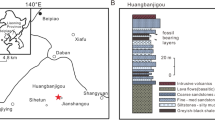Abstract
Eohomopterus simojovelensis n. sp., the first fossil record of the subfamily Paussinae (Coleoptera: Carabidae) from the Miocene amber of the Simojovel area, Chiapas, Mexico, is described. The morphology of the new species is compared withEohomopterus poinari Nagel, 1997 from Dominican amber as well as with extant representatives ofEohomopterus, and the biogeographical implications are discussed.
Kurzfassung
Der erste Vertreter der Paussinae (Coleoptera: Carabidae)Eohomopterus simojovelensis n. sp., wird aus dem mexikanischen Bernstein (Simojovel Gebiet, Chiapas, Mexiko; Miozän) beschrieben. Die Morphologie dieser neuen Art wird mitEohomopterus poinari Nagel, 1997 aus dem Dominikanischen Bernstein sowie mit rezenten Angehörigen vonEohomopterus verglichen, und die biogeographischen Beziehungen werden diskutiert.
Similar content being viewed by others
References
Amorim, D.S. 1998. Amber Fossil Scatopsidae (Diptera: Psychodomorpha). I. Considerations on described taxa,Procolobostema roseni, new species, from Dominican amber, and the position ofProcolobostema in the family. — American Museum Novitates3227: 1–17.
Andrade, M.L. 1995. The ant genusAphaenogaster in Dominican and Mexican amber (Amber Collection Stuttgart; Hymenoptera, Formicidae; IX, Pheidolini). — Stuttgarter Beiträge zur Naturkunde B223: 1–11.
Andrade, M.L. &Baroni, U.C. 1999. Diversity and adaptation in the ant genusCephalotes, past and present. — Stuttgarter Beiträge zur Naturkunde B227: 1–889.
Darlington, P.J., Jr. 1950. Paussid Beetles. — Transactions of the American Entomological Society76: 47–142.
Darlington, P.J. 1964. Paussid beetles in Mexico. — Psyche, Cambridge Entomological Club71 (3): 150–152.
Garcia-Villafuerte, M.A. &Penney, D. 2003.Lyssomanes (Araneae: Salticidae) in Oligocene-Miocene Chiapas Amber. — Journal of Arachnology31: 400–404.
Iturralde-Vinent, M.A. &MacPhee, R.D.E. 1999. Implications for Cenozoic Biogeography. — Bulletin of the American Museum of Natural History238: 1–195.
Iturralde-Vinent, M.A. 2001. Geology of the Amber-Bearing Deposits of the Greater Antilles. — Caribbean Journal of Science37 (3/4): 141–167.
Kolbe, H. 1920. Die Paussiden Südamerikas. — Entomologische Mitteilungen9: 131–156.
Latreille, P.A. 1802. Histoire Naturelle, générale et particulare des Crustacés et des Insectes. Ouverege faisant suite a I’Histoire Naturelle générale et particulare, composée par Leclerc de Buffon, et rédigé par C.S. Sonnini, membre de plusieurs Sociétés savantes. Familles naturelles de Genres. — 467 p., Paris (Amand Koenig).
Latreille, P.A. 1807. Genera crustaceorum et insectorum, secundum ordinem naturalem in familias disposita, iconibus exemplisque plurimis explicata. — 258 p., Paris (Amand Koenig).
Luna de Carvalho, E. 1960. Essai monographique sur les Paussides paléarctiques. — Atti della Società Italiana di Scienze Naturali99: 344–360.
Nagel, P. 1987a. Arealsystemanalyse afrikanischer Fühlerkäfer (Coleoptera, Carabidae, Paussinae). Ein Beitrag zur Rekonstruktion der Landschaftsgenese. — 233 p., Stuttgart, Wiesbaden (F. Steiner).
Nagel, P. 1987b. Fossil ant nest beetles (Coleoptera: Carabidae: Paussina). — Entomologische Arbeiten aus dem Museum G. Frey35/36: 137–170.
Nagel, P. 1997. New fossil paussids from Dominican amber with notes on the phylogenetic systematics of the paussine complex (Coleoptera: Carabidae). — Systematic Entomology22: 345–362.
Poinar, G.O., Jr. 1992. Life in Amber. — 350 p., Stanford (Stanford University Press).
Wappler, T. 2003. Systematik, Taphonomie und Paläoökologie der Insekten aus dem Mittel-Eozän des Eckfelder Maares, Vulkaneifel. — Clausthaler Geowissenschaften2 (8): 1–241.
Wasmann, E.S.J. 1899. Neue Paussiden, mit einem biologischen Nachtrag. — Notes from the Leyden Museum21: 33–52.
Wasmann, E.S.J. 1919. Über unsere Kenntnis der fossilen Paussiden. — Tijdschrift voor Entomologie57: 40–44.
Wasmann, E.S.J. 1926a. Die Paussidengattungen des baltischen Bernsteins. (265. Beitrag zur Kenntnis der Myrmecophilen). — Zoologischer Anzeiger68: 25–30.
Wasmann, E.S.J. 1926b. DieArthropterus-Formen des baltischen Bernsteins. (267. Beitrag zur Kenntnis der Myrmecophilen). — Zoologischer Anzeiger68: 225–232.
Wasmann, E.S.J. 1929. Die Paussiden des baltischen Bernsteins und die Stammesgeschichte der Paussiden. — In:Andrée, K., ed., Bernstein-Forschungen (Amber studies): 1–110, Berlin, Leipzig (W. de Gruyter & Co).
Author information
Authors and Affiliations
Corresponding author
Rights and permissions
About this article
Cite this article
Solórzano Kraemer, M.M. The first fossil Paussine (Coleoptera: Carabidae) from Mexican amber. Paläontol Z 80, 107–111 (2006). https://doi.org/10.1007/BF02988970
Received:
Accepted:
Issue Date:
DOI: https://doi.org/10.1007/BF02988970




